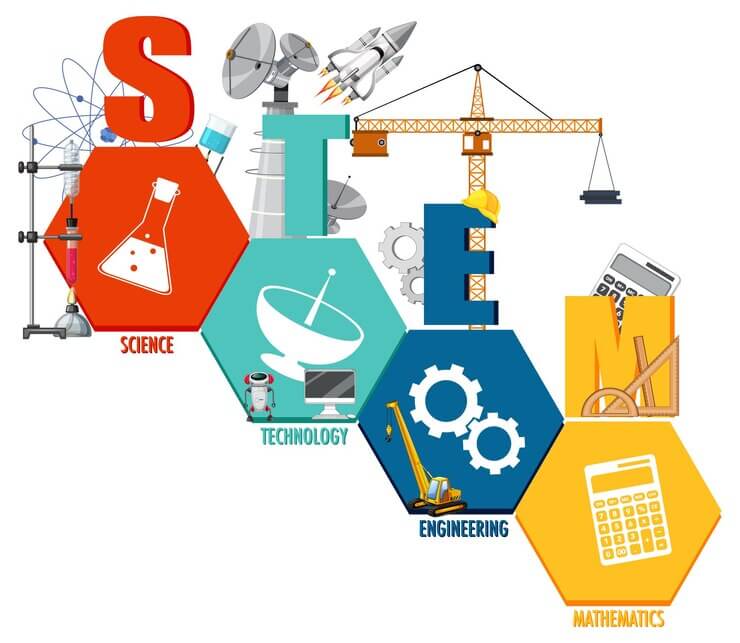STEM, stands for Science, Technology, Engineering, and Mathematics, an interdisciplinary approach to education and professional development by seamlessly integrating these four fields.
It imparts versatile skills, focused on nurturing critical thinking, problem-solving, and innovation. Subsequently, these skills are applicable across various industries. Moreover, it is intending to deepen comprehension of the natural world and propel technological advancements.
In navigating the intricacies of the 21st century, it emerges as a potent force propelling progress and innovation. Therefore, in addressing the global challenges, the role of Science, Technology, Engineering, and Mathematics is unparalleled. Hence, the investment in Science, Technology, Engineering, and Mathematics education, cultivation of inclusivity, and embracement of limitless opportunities pave the way for a future where human ingenuity knows no bounds.
STEM transcends being a mere acronym; hence, it stands as a transformative force shaping our world and future generations. Within the dynamic world of STEM, where the pursuit of knowledge knows no gender boundaries, persistent gender gaps have hindered women’s full participation in these fields.
This blog aims to uncover the challenges faced by women in STEM, as well as, explore initiatives promoting gender diversity, and highlight the achievements of women pioneers. Additionally, emphasize the paramount importance of fostering an inclusive and supportive environment.
Challenges faced by Women in STEM

Gender Bias and Stereotypes
Women often grapple with gender bias and stereotypes, perpetuating the misconception that certain Science, Technology, Engineering, and Mathematics fields are more suited for men.
Underrepresentation
The lack of visible female role models and mentors can discourage women from pursuing STEM careers. Therefore, the increased representation is paramount for a healthy culture within our societies.
Workplace Challenges
Workplace discrimination, from biased hiring processes to limited opportunities for career advancement. Hence, it poses barriers, which must be addressed for equity in the professional landscape.
STEM: Initiatives Promoting Gender Diversity
Combining the strategies and maintaining a long-term commitment to gender diversity can contribute to a more inclusive STEM landscape. Therefore, benefiting individuals, organizations, and society as a whole. The below initiatives are critical for promoting gender diversity in STEM:
STEM: Educational Overhauls
Early Exposure: Introducing STEM concepts to girls at an early age can help spark interest and confidence. Also, programs like workshops, camps, and outreach activities can break down stereotypes and encourage girls to explore.
Equal Opportunities: Ensuring that girls have equal access to educational resources, extracurricular activities, and advanced coursework is crucial. Moreover, addressing any biases in teaching materials and methods can contribute to a more inclusive learning environment.
STEM Mentorship Networks
Professional Guidance: Mentorship programs provide a platform for women in STEM to connect with experienced professionals who can offer advice, share insights, and provide guidance. Hence, this helps in fostering a sense of community and support.
Role Models: Exposure to successful women in STEM through mentorship can serve as powerful role models, inspiring confidence and determination among aspiring female scientists, engineers, and technologists.
Policy Reforms
Diversity and Inclusion Policies: Organizations should actively work towards creating and implementing policies that foster diversity and inclusion. This includes recruitment practices, promotion criteria, and addressing any gender pay gaps. Additionally, a commitment to diversity at all levels of an organization is essential.
Flexible Work Arrangements: Policies that support flexible work schedules, remote work options, and family-friendly benefits can contribute to a more inclusive workplace, as well as, accommodating diverse needs, and helping to retain women in STEM careers.
Community Engagement
Networking Events: Hosting events that bring together professionals, students, and educators in STEM can facilitate networking opportunities. Hence, this can help create a sense of community, share success stories, and provide a platform for discussing challenges faced by women.
Public Awareness Campaigns: Raising awareness through public campaigns and media outreach can challenge societal norms and stereotypes, as well as, promote a more inclusive perspective.
Success Stories of Women in STEM
Dr. Frances Arnold – Nobel Laureate in Chemistry
Pioneering work in enzyme evolution earned Dr. Arnold the Nobel Prize, showcasing the profound impact of women in scientific breakthroughs.
Grace Hopper – Computer Scientist and Navy Rear Admiral
As a trailblazer in computer science, Rear Admiral Grace Hopper left an indelible mark on the field’s development through her contributions to early programming languages.
Dr. Hayat Sindi – Biotechnologist and Entrepreneur
Dr. Hayat Sindi is a biotechnologist and the co-founder of Diagnostics For All, a nonprofit organization focused on developing low-cost diagnostic devices for underserved populations. Moreover, she has been a trailblazer in applying science and technology to address global health challenges.
STEM: Importance of an Inclusive Environment
Driving Innovation
Diversity within STEM environments fosters innovation by welcoming a spectrum of perspectives and driving creative solutions to complex challenges.
Equalizing Opportunities
An inclusive STEM landscape is pivotal in closing the gender pay gap as well as ensuring equitable compensation for women’s contributions.
Global Impact
A diverse and inclusive workforce is better equipped to address global challenges, with women contributing unique insights across various scientific domains.
Conclusion
In the journey to break barriers and bridge the gender gap, acknowledging challenges as well as championing diversity initiatives, and celebrating women pioneers are imperative. Creating an inclusive environment is not just a goal; it is a catalyst for innovation, progress, and the collective advancement of society. Striving for equality, therefore, let us collectively propel STEM into a world where talent knows no gender, and the pursuit of knowledge is truly boundless.







